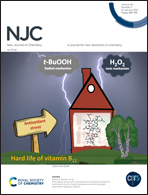A pyrrolopyridazinedione-based copolymer for fullerene-free organic solar cells†
Abstract
The recent success of non-fullerene acceptors in organic photovoltaics also entails a change in the requirements to the polymer donor in terms of optical and morphological properties leading to a demand for novel conjugated polymers. Herein, we report on the synthesis of a 1,4-bis-(thiophene-2-yl)-pyrrolopyridazinedione based copolymer with 2-ethylhexyl substituents on the pyrrolopyridazinedione moiety. A 2D conjugated benzodithiophene (BDT) was chosen as comonomer. The resulting copolymer T-EHPPD-T-EHBDT showed a molecular weight of 10.2 kDa, an optical band gap of 1.79 eV, a hole mobility of 1.8 × 10−4 cm2 V−1 s−1 and a preferred face-on orientation with regard to the substrate. The comparably wide band gap as well as the determined energy levels (HOMO: −5.47 eV, LUMO: −3.68 eV) match well with the narrow band gap non-fullerene acceptor ITIC-F, which was used as the acceptor phase in the bulk heterojunction absorber layers in the investigated solar cells. The solar cells, prepared in inverted architecture, revealed power conversion efficiencies up to 7.4% using a donor:acceptor ratio of 1 : 1 in the absorber layer.



 Please wait while we load your content...
Please wait while we load your content...